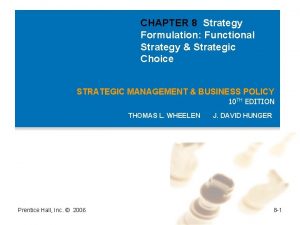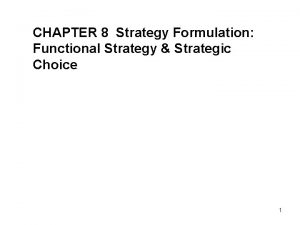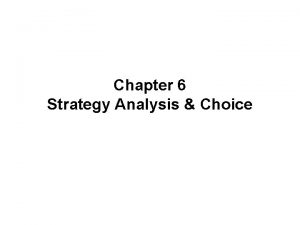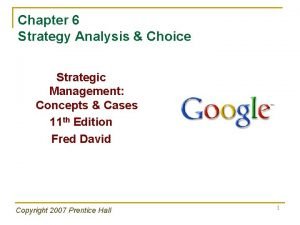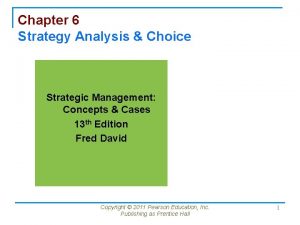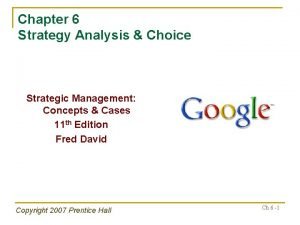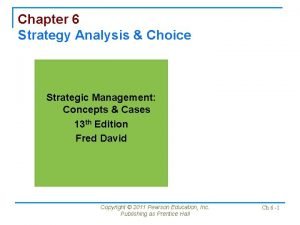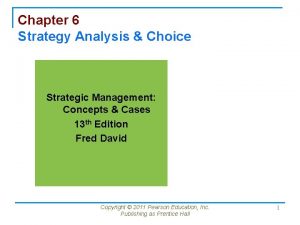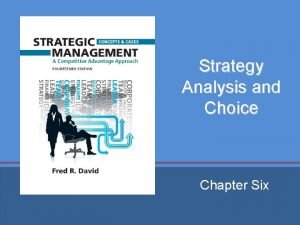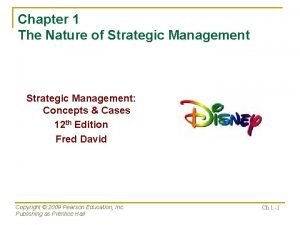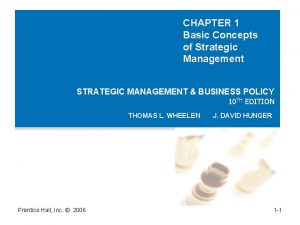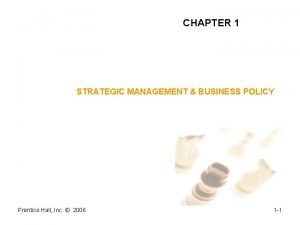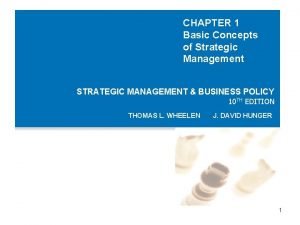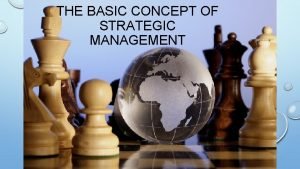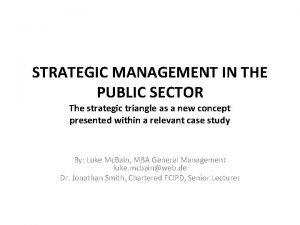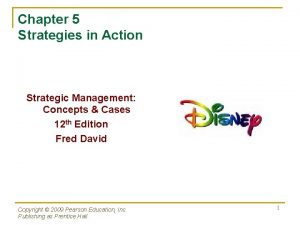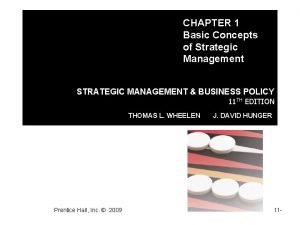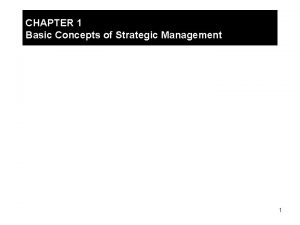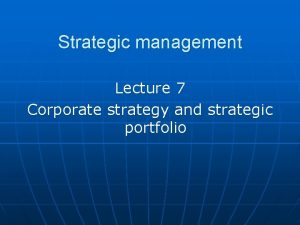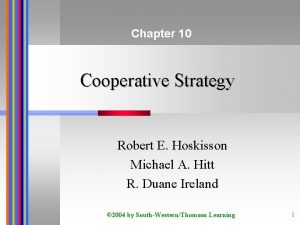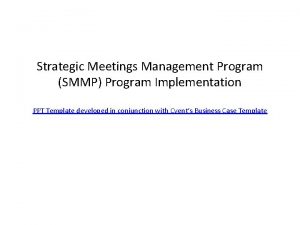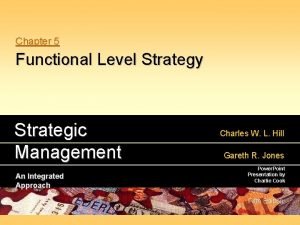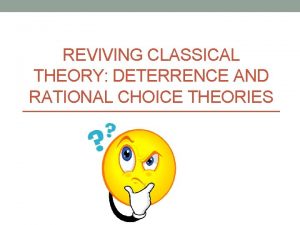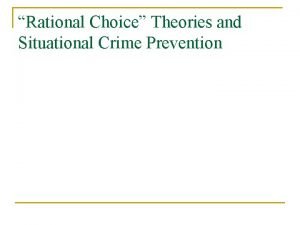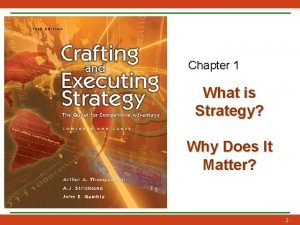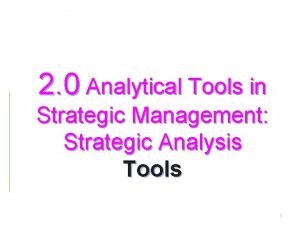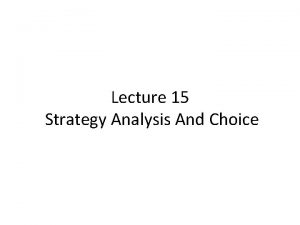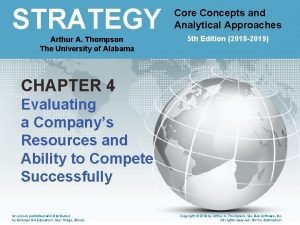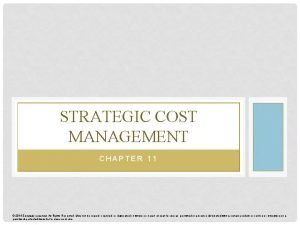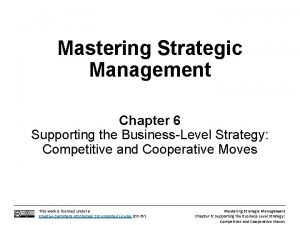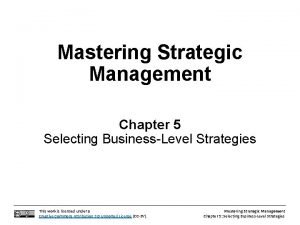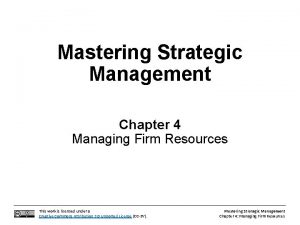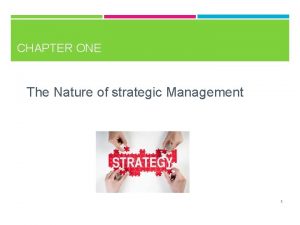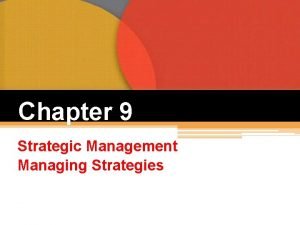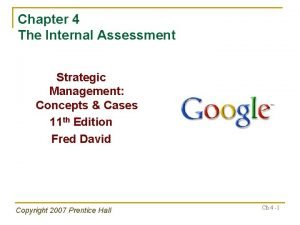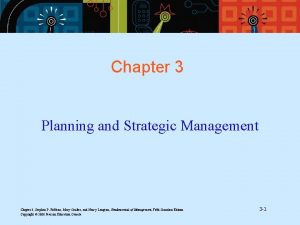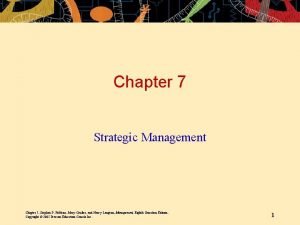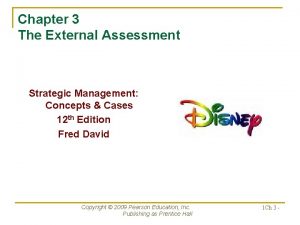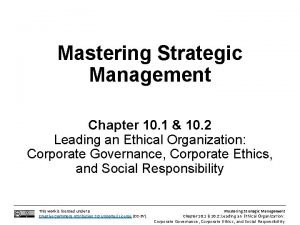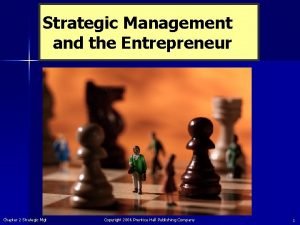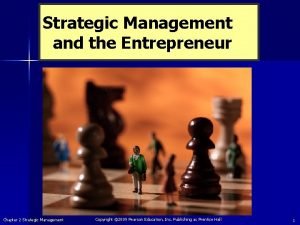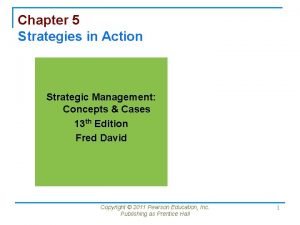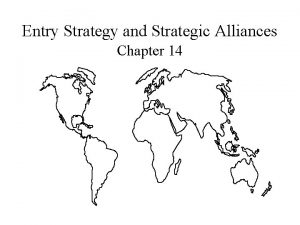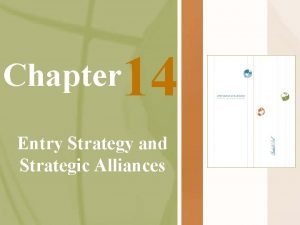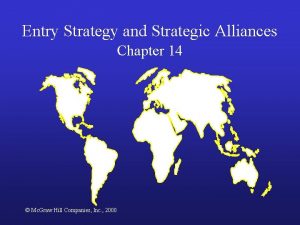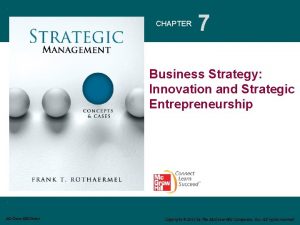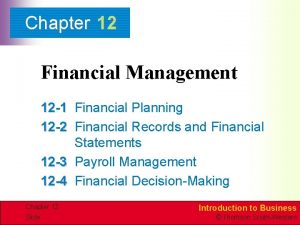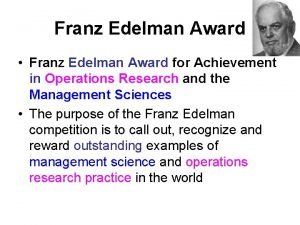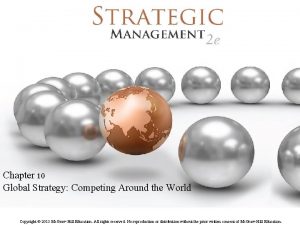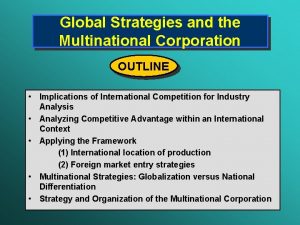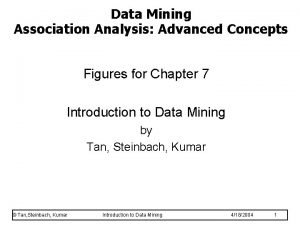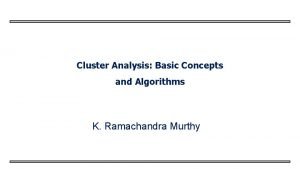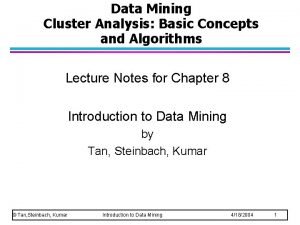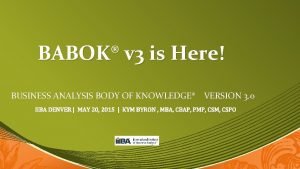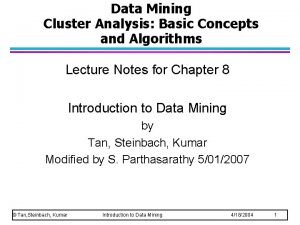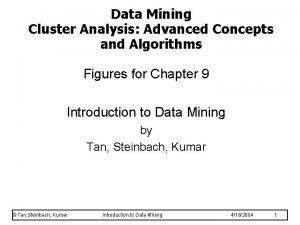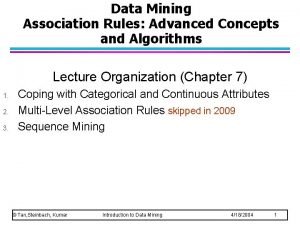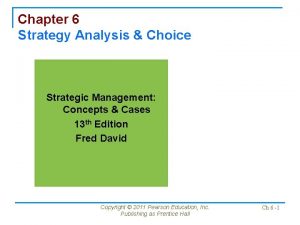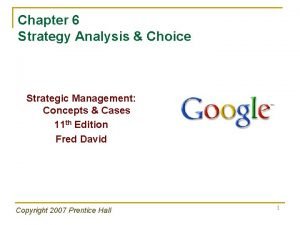Chapter 6 Strategy Analysis Choice Strategic Management Concepts























































































- Slides: 87

Chapter 6 Strategy Analysis & Choice Strategic Management: Concepts & Cases 12 th Edition Fred David Copyright © 2009 Pearson Education, Inc. Publishing as Prentice Hall 1

Chapter Outline The Nature of Strategy & Choice A Comprehensive Strategy-Formulation Framework The Input Stage Copyright © 2009 Pearson Education, Inc. Publishing as Prentice Hall 2

Chapter Outline (cont’d) The Matching Stage The Decision Stage Cultural Aspects of Strategy Choice Copyright © 2009 Pearson Education, Inc. Publishing as Prentice Hall 3

Chapter Outline (cont’d) The Politics of Strategy Choice Governance Issues Copyright © 2009 Pearson Education, Inc. Publishing as Prentice Hall 4

Strategy Analysis & Choice Nature of Strategy Analysis & Choice – Establishing long-term objectives – Generating alternative strategies – Selecting strategies to pursue – Best alternative – achieve mission & objectives Copyright © 2009 Pearson Education, Inc. Publishing as Prentice Hall 5

Copyright © 2009 Pearson Education, Inc. Publishing as Prentice Hall 6

Strategy Analysis & Choice Alternative Strategies Derive From – n n n Vision Mission Objectives External audit Internal audit Past successful strategies Copyright © 2009 Pearson Education, Inc. Publishing as Prentice Hall 7

The Process of Generating and Selecting Strategies n 1. Strategists never consider all feasible alternatives that could benefit the firm, because there an infinite number of possible actions and an infinite number of ways to implement those actions. Therefore, a manageable set of the most attractive alternative strategies must be developed. Copyright © 2009 Pearson Education, Inc. Publishing as Prentice Hall 8

The Process of Generating and Selecting Strategies n n 2. Identifying and evaluating alternative strategies should involve many of the managers and employees who earlier assembled the organizational mission statement, performed the external audit, and conducted the internal audit. 3. Alternative strategies proposed by participants should be considered and discussed in a meeting or series of meetings. Copyright © 2009 Pearson Education, Inc. Publishing as Prentice Hall 9

Natural Environment Perspective What Is a Sustainability Report? n n Sustainability (corporate social-responsibility) reports disclose policies to shareholders Global Reporting Initiative has issued a set of detailed reporting guidelines Wal-Mart and Kohl’s installing solar panels Home Depot doubled offerings of environmentally friendly products Copyright © 2009 Pearson Education, Inc. Publishing as Prentice Hall 10

Strategy Analysis & Choice Generating Alternatives – Participation in generating alternative strategies should be as broad as possible Copyright © 2009 Pearson Education, Inc. Publishing as Prentice Hall 11

Copyright © 2009 Pearson Education, Inc. Publishing as Prentice Hall 12

Comprehensive Strategy-Formulation Framework Stage 1: The Input Stage 2: The Matching Stage Copyright © 2009 Pearson Education, Inc. Publishing as Prentice Hall Stage 3: The Decision Stage 13

Strategy-Formulation Analytical Framework Internal Factor Evaluation Matrix (IFE) Stage 1: The Input Stage External Factor Evaluation Matrix (EFE) Competitive Profile Matrix (CPM) Copyright © 2009 Pearson Education, Inc. Publishing as Prentice Hall 14

Stage 1: The Input Stage §Basic input information for the matching & decision stage matrices §Requires strategists to quantify subjectivity early in the process §Good intuitive judgment always needed Copyright © 2009 Pearson Education, Inc. Publishing as Prentice Hall 15

Strategy-Formulation Analytical Framework SWOT Matrix SPACE Matrix Stage 2: The Matching Stage BCG Matrix IE Matrix Grand Strategy Matrix Copyright © 2009 Pearson Education, Inc. Publishing as Prentice Hall 16

Stage 2: The Matching Stage §Match between organization’s internal resources & skills and the opportunities & risks created by its external factors Copyright © 2009 Pearson Education, Inc. Publishing as Prentice Hall 17

Stage 2: The Matching Stage SWOT Matrix §Strengths §Weaknesses §Opportunities §Threats Copyright © 2009 Pearson Education, Inc. Publishing as Prentice Hall 18

SWOT Matrix Four Types of Strategies §Strengths-Opportunities (SO) §Weaknesses-Opportunities (WO) §Strengths-Threats (ST) §Weaknesses-Threats (WT) Copyright © 2009 Pearson Education, Inc. Publishing as Prentice Hall 19

SO Strategies Strengths Weaknesses Opportunities Threats SWOT SO Strategies Copyright © 2009 Pearson Education, Inc. Publishing as Prentice Hall Use a firm’s internal strengths to take advantage of external opportunities 20

WO Strategies Strengths Weaknesses Opportunities Threats SWOT WO Strategies Copyright © 2009 Pearson Education, Inc. Publishing as Prentice Hall Improving internal weaknesses by taking advantage of external opportunities 21

ST Strategies Strengths Weaknesses Opportunities Threats SWOT ST Strategies Copyright © 2009 Pearson Education, Inc. Publishing as Prentice Hall Use a firm’s strengths to avoid or reduce the impact of external threats 22

WT Strategies Strengths Weaknesses Opportunities Threats SWOT WT Strategies Copyright © 2009 Pearson Education, Inc. Publishing as Prentice Hall Defensive tactics aimed at reducing internal weaknesses & avoiding environmental threats 23

SWOT Matrix Developing the SWOT §List firm’s key internal Strengths §List firm’s key internal Weaknesses §List firm’s key external Opportunities §List firm’s key external Threats Copyright © 2009 Pearson Education, Inc. Publishing as Prentice Hall 24

SWOT Matrix Strengths – S Weaknesses – W List Strengths List Weaknesses Opportunities – O SO Strategies WO Strategies List Opportunities Use strengths to take advantage of opportunities Overcoming weaknesses by taking advantage of opportunities Threats – T ST Strategies WT Strategies List Threats Use strengths to avoid threats Minimize weaknesses and avoid threats Copyright © 2009 Pearson Education, Inc. Publishing as Prentice Hall 25

Limitations with SWOT Matrix n n n Does not show to achieve a competitive advantage Provides a static assessment in time May lead the firm to overemphasize a single internal or external factor in formulating strategies Copyright © 2009 Pearson Education, Inc. Publishing as Prentice Hall 26

Strategy-Formulation Analytical Framework SWOT Matrix SPACE Matrix Stage 2: The Matching Stage BCG Matrix IE Matrix Grand Strategy Matrix Copyright © 2009 Pearson Education, Inc. Publishing as Prentice Hall 27

SPACE Matrix Strategic Position & Action Evaluation Matrix § This vector reveals the type of strategies recommended for the organization. § Aggressive § Conservative § Defensive § Competitive Copyright © 2009 Pearson Education, Inc. Publishing as Prentice Hall 28

SPACE Matrix Two Internal Dimensions §Financial Strength (FS) §Competitive Advantage (CA) Copyright © 2009 Pearson Education, Inc. Publishing as Prentice Hall 29

SPACE Matrix Two External Dimensions §Environmental Stability (ES) §Industry Strength (IS) Copyright © 2009 Pearson Education, Inc. Publishing as Prentice Hall 30

SPACE Factors Internal Strategic Position External Strategic Position Financial Strength (FS) Environmental Stability (ES) Return on investment Leverage Liquidity Working capital Cash flow Inventory turnover Earnings per share Price earnings ratio Technological changes Rate of inflation Demand variability Price range of competing products Barriers to entry Competitive pressure Copyright © 2009 Pearson Education, Inc. Publishing as Prentice Hall Price elasticity of demand Ease of exit from market Risk involved in business 31

SPACE Factors Internal Strategic Position External Strategic Position Competitive Advantage (CA) Industry Strength (IS) Market share Product quality Product life cycle Customer loyalty Competition’s capacity utilization Technological know-how Control over suppliers & distributors Growth potential Profit potential Financial stability Technological know-how Resource utilization Ease of entry into market Productivity, capacity utilization Copyright © 2009 Pearson Education, Inc. Publishing as Prentice Hall 32

Steps to Developing a SPACE Matrix Select a set of variables to define FS, CA, ES, and IS. Assign a numerical value: 1. 2. 1. 2. 3. From +1 to +6 to each FS & IS dimension From -1 to -6 to each ES & CA dimension Compute an average score for each FS, CA, ES, and IS. Copyright © 2009 Pearson Education, Inc. Publishing as Prentice Hall 33

Steps to Developing a SPACE Matrix 4. 5. 6. Plot the average score on the appropriate axis. Add the two scores on the x-axis and plot the point. Add the two scores on the y-axis and plot the point. Plot the intersection of the new xy point. Draw a directional vector from the origin through the new intersection point. Copyright © 2009 Pearson Education, Inc. Publishing as Prentice Hall 34

Copyright © 2009 Pearson Education, Inc. Publishing as Prentice Hall 35

Strategy-Formulation Analytical Framework SWOT Matrix SPACE Matrix Stage 2: The Matching Stage BCG Matrix IE Matrix Grand Strategy Matrix Copyright © 2009 Pearson Education, Inc. Publishing as Prentice Hall 36

BCG Matrix Boston Consulting Group Matrix §Enhances multidivisional firm in formulating strategies §Autonomous divisions = business portfolio §Divisions may compete in different industries §Focus on market-share position & industry growth rate Copyright © 2009 Pearson Education, Inc. Publishing as Prentice Hall 37

BCG Matrix Relative Market Share Position §Ratio of a division’s own market share in an industry to the market share held by the largest rival firm in that industry Copyright © 2009 Pearson Education, Inc. Publishing as Prentice Hall 38

Copyright © 2009 Pearson Education, Inc. Publishing as Prentice Hall 39

BCG Matrix Question Marks §Low relative market share, competes in highgrowth industry §Cash needs are high §Case generation is low §Decision to strengthen (intensive strategies) or divest Copyright © 2009 Pearson Education, Inc. Publishing as Prentice Hall 40

BCG Matrix Stars §High relative market share and high growth rate §Best long-run opportunities for growth & profitability §Substantial investment to maintain or strengthen dominant position §Integration strategies, intensive strategies, joint ventures Copyright © 2009 Pearson Education, Inc. Publishing as Prentice Hall 41

BCG Matrix Cash Cows §High relative market share, competes in lowgrowth industry §Generate cash in excess of their needs §Milked for other purposes §Maintain strong position as long as possible §Product development, concentric diversification §If weakens – retrenchment or divestiture Copyright © 2009 Pearson Education, Inc. Publishing as Prentice Hall 42

BCG Matrix Dogs §Low relative market share, competes in slow or no market growth §Weak internal & external position §Liquidation, divestiture, retrenchment Copyright © 2009 Pearson Education, Inc. Publishing as Prentice Hall 43

Strategy-Formulation Analytical Framework SWOT Matrix SPACE Matrix Stage 2: The Matching Stage BCG Matrix IE Matrix Grand Strategy Matrix Copyright © 2009 Pearson Education, Inc. Publishing as Prentice Hall 44

The Internal-External Matrix n n Positions an organization’s various divisions in a nine-cell display Similar to BCG Matrix except the IE Matrix: q q q Axes are different Requires more information about the divisions Strategic implications of each matrix are different Copyright © 2009 Pearson Education, Inc. Publishing as Prentice Hall 45

Copyright © 2009 Pearson Education, Inc. Publishing as Prentice Hall 46

IE Matrix n Based on two key dimensions q q n The IFE total weighted scores on the x-axis The EFE total weighted scores on the y-axis Divided into three major regions q q q Grow and build – Cells I, II, or IV Hold and maintain – Cells III, V, or VII Harvest or divest – Cells VI, VIII, or IX Copyright © 2009 Pearson Education, Inc. Publishing as Prentice Hall 47

Copyright © 2009 Pearson Education, Inc. Publishing as Prentice Hall 48

Strategy-Formulation Analytical Framework SWOT Matrix SPACE Matrix Stage 2: The Matching Stage BCG Matrix IE Matrix Grand Strategy Matrix Copyright © 2009 Pearson Education, Inc. Publishing as Prentice Hall 49

Grand Strategy Matrix § Tool formulating alternative strategies § Based on two dimensions § Competitive position § Market growth Copyright © 2009 Pearson Education, Inc. Publishing as Prentice Hall 50

RAPID MARKET GROWTH 1. 2. 3. 4. 5. 6. WEAK COMPETITIVE POSITION 1. 2. 3. 4. 5. Quadrant II Market development Market penetration Product development Horizontal integration Divestiture Liquidation 1. 2. 3. 4. 5. 6. 7. Quadrant I Market development Market penetration Product development Forward integration Backward integration Horizontal integration Concentric diversification Quadrant III Quadrant IV Retrenchment 1. Concentric diversification 2. Horizontal diversification 3. Conglomerate diversification 4. Joint ventures Liquidation SLOW MARKET GROWTH Copyright © 2009 Pearson Education, Inc. Publishing as Prentice Hall STRONG COMPETITIVE POSITION 51

Grand Strategy Matrix Quadrant I §Excellent strategic position §Concentration on current markets/products §Take risks aggressively when necessary Copyright © 2009 Pearson Education, Inc. Publishing as Prentice Hall 52

Grand Strategy Matrix Quadrant II §Evaluate present approach §How to improve competitiveness §Rapid market growth requires intensive strategy Copyright © 2009 Pearson Education, Inc. Publishing as Prentice Hall 53

Grand Strategy Matrix Quadrant III §Compete in slow-growth industries §Weak competitive position §Drastic changes quickly §Cost & asset reduction (retrenchment) Copyright © 2009 Pearson Education, Inc. Publishing as Prentice Hall 54

Grand Strategy Matrix Quadrant IV §Strong competitive position §Slow-growth industry §Diversification to more promising growth areas Copyright © 2009 Pearson Education, Inc. Publishing as Prentice Hall 55

Strategy-Formulation Analytical Framework Stage 3: The Decision Stage Copyright © 2009 Pearson Education, Inc. Publishing as Prentice Hall Quantitative Strategic Planning Matrix (QSPM) 56

QSPM Quantitative Strategic Planning Matrix §Technique designed to determine the relative attractiveness of feasible alternative actions Copyright © 2009 Pearson Education, Inc. Publishing as Prentice Hall 57

Strategic Alternatives QSPM Key External Factors Economy Political/Legal/Governmental Social/Cultural/Demographic/ Environmental Technological Competitive Weight Strategy 1 Strategy 2 Strategy 3 Key Internal Factors Management Marketing Finance/Accounting Production/Operations Research and Development Computer Information Systems Copyright © 2009 Pearson Education, Inc. Publishing as Prentice Hall 58

Steps to Develop a QSPM 1. 2. 3. Make a list of the firm’s key external opportunities/threats and internal strengths/weaknesses in the left column. Assign weights to each key external and internal factor. Examine the Stage 2 (matching) matrices, and identify alternative strategies that the organization should consider implementing. Copyright © 2009 Pearson Education, Inc. Publishing as Prentice Hall 59

Steps to Develop a QSPM 4. 5. 6. Determine the Attractiveness Scores. Compare the Total Attractiveness Scores. Compute the Sum Total Attractiveness Score. Copyright © 2009 Pearson Education, Inc. Publishing as Prentice Hall 60

QSPM Limitations §Requires intuitive judgments & educated assumptions §Only as good as the prerequisite inputs Copyright © 2009 Pearson Education, Inc. Publishing as Prentice Hall 61

QSPM Advantages §Sets of strategies considered simultaneously or sequentially §Integration of pertinent external & internal factors in the decision-making process Copyright © 2009 Pearson Education, Inc. Publishing as Prentice Hall 62

Cultural Aspects of Strategy Choice Organization Culture §Successful strategies depend on the degree of consistency with the firm’s culture Copyright © 2009 Pearson Education, Inc. Publishing as Prentice Hall 63

Cultural Aspects of Strategy Choice n It is beneficial to view strategic management from a cultural perspective because success often rests on the degree of support that strategies receive from a firm’s culture. Copyright © 2009 Pearson Education, Inc. Publishing as Prentice Hall 64

Cultural Aspects of Strategy Choice n n If a firm’s strategies are supported by cultural products such as values, beliefs, rites, rituals, ceremonies, stories, symbols, language, heroes, and heroines, then managers often can implement changes swiftly and easily. Strategies that require fewer cultural changes may be more attractive because extensive changes can take considerable time and effort. Copyright © 2009 Pearson Education, Inc. Publishing as Prentice Hall 65

Cultural Aspects of Strategy Choice n In the absence of objective analyses, strategy decisions too often are based on the politics of the moment. With development of improved strategyformulation tools, political factors become less important in making strategic decisions. Copyright © 2009 Pearson Education, Inc. Publishing as Prentice Hall 66

Politics of Strategy Choice Politics in Organizations §Management hierarchy §Career aspirations §Allocation of scarce resources Copyright © 2009 Pearson Education, Inc. Publishing as Prentice Hall 67

Politics of Strategy Choice Political Tactics for Strategists §Equifinality: give flexibility to use different techniques. §Satisfying: achieving satisfactory results with acceptable strategies. §Generalization: shifting focus from specific to general ones. §Higher-order issues: postponed short-term in favor of long term. E. g. , focus on survival and give concession to union on wage increase. §Political access on important issues Copyright © 2009 Pearson Education, Inc. Publishing as Prentice Hall 68

Governance Issues Board of Directors Roles & Responsibilities §Control & oversight over management §Adherence to legal prescriptions §Consideration of stakeholder interests §Advancement of stockholder rights Copyright © 2009 Pearson Education, Inc. Publishing as Prentice Hall 69

Global Perspective Corporate Tax Rates Worldwide – Europe is Lowest n n Lowest corporate tax rates reside in Europe and European countries Average tax rate in EU countries is 26% Besides tax rates, large markets and affluent markets attract new businesses Taxes can be used to reward or penalize companies for locating locally or moving overseas Copyright © 2009 Pearson Education, Inc. Publishing as Prentice Hall 70

Corporate Governance Issues Business. Week’s “Principles of Good Governance” 1. No more than 2 directors are current or former company executives 2. No directors do business with the company 3. Audit, compensation, and nominating committees made up of outside directors 4. Each director owns a large equity stake in the company 5. At least one outside director with extensive experience 6. Fully employed directors sit on no more than 4 boards, retirees on no more than 7 7. Each director attends at least 75% of all meetings Copyright © 2009 Pearson Education, Inc. Publishing as Prentice Hall 71

Corporate Governance Issues Business Week’s “principles of good governance” 8. Board meets regularly without management present 9. Audit committee meets at least four times a year 10. Board is frugal on executive pay, diligent in CEO succession, and prompt to act when trouble arises 11. CEO is not also the chairperson of the board 12. Shareholders have considerable power and information to choose & replace directors 13. Stock options are considered a corporate expense 14. No interlocking directorships Copyright © 2009 Pearson Education, Inc. Publishing as Prentice Hall 72

For Review (Chapter 6) Key Terms & Concepts Aggressive Quadrant Business Portfolio Attractiveness Scores (AS) Cash Cows Board of Directors Competitive Advantage (CA) Boston Consulting Group (BCG) Matrix Competitive Quadrant Copyright © 2009 Pearson Education, Inc. Publishing as Prentice Hall 73

For Review (Chapter 6) Key Terms & Concepts Conservative Quadrant Dogs Culture Environmental Stability (ES) Defensive Quadrant Financial Strength (FS) Directional Vector Governance Copyright © 2009 Pearson Education, Inc. Publishing as Prentice Hall 74

For Review (Chapter 6) Key Terms & Concepts Grand Strategy Matrix Internal-External (IE) Matrix Halo Error Matching Industry Strength (IS) Matching Stage Input Stage Quantitative Strategic Planning Matrix (QSPM) Copyright © 2009 Pearson Education, Inc. Publishing as Prentice Hall 75

For Review (Chapter 6) Key Terms & Concepts Question Marks Stars Relative Market Share Position Strategic Position & Action Evaluation (SPACE) SO Strategies Sum Total Attractiveness Score (STAS) ST Strategies Sustainability Copyright © 2009 Pearson Education, Inc. Publishing as Prentice Hall 76

For Review (Chapter 6) Key Terms & Concepts Strengths, Weaknesses, Opportunities, Threats (SWOT) WO Strategies Total Attractiveness Scores (TAS) WT Strategies Copyright © 2009 Pearson Education, Inc. Publishing as Prentice Hall 77

Review n n How would application of the strategyformulation framework differ from a small to a large organization? The strategy-formulation framework is conceptually identical for both small and large organizations. However, in large organizations, there are more variables to analyze and forecast. This makes the strategy-formulation process more complex. Copyright © 2009 Pearson Education, Inc. Publishing as Prentice Hall 78

Review n n n n Given the information in the table below, develop a BCG Matrix and an IE Matrix. Divisions 1 2 3 Profits $10 $15 $25 Sales $100 $50 $100 Relative Market Share 0. 2 0. 5 0. 8 Industry Growth Rate +. 20 +. 10 -. 10 IFE Total Weighted Success 1. 6 3. 1 2. 2 EFE Total Weighted Success 2. 5 1. 8 3. 3 Copyright © 2009 Pearson Education, Inc. Publishing as Prentice Hall 79

Review n n n n Explain the steps involved in developing a QSPM. Answer: There are six basic steps involved in applying QSPM: Make a list of the firm’s key external opportunities/threats and internal strengths/weaknesses in the left column of the QSPM. Assign weights to each key external and internal factor. Examine the Stage 2 matrices and identify alternative strategies that the organization should consider implementing. Determine the AS. Compute the total AS. Compute the sum Total AS Copyright © 2009 Pearson Education, Inc. Publishing as Prentice Hall 80

Review n n What do you think is the appropriate role of a board of directors in strategic management? Why? Answer: Board members should review strategy formulation, implementation, and evaluation reports. As described in the chapter, board members are, more and more, being held personally liable for failed strategies in organizations. Board members should provide input, advice, suggestions, and comments about strategic-management activities. Copyright © 2009 Pearson Education, Inc. Publishing as Prentice Hall 81

Review n n Explain why cultural factors should be an important consideration in analyzing and choosing among alternative strategies. Answer: Cultural factors are an integral part of everyday life in organizations. An organization’s unique culture represents the heart of work. Thus, in choosing among alternative strategies for an organization, consideration should be given to the different levels of support that proposed strategies would receive from existing cultural products. Consideration should also be given to whether cultural changes could be achieved readily. Copyright © 2009 Pearson Education, Inc. Publishing as Prentice Hall 82

Review n n How are the SWOT Matrix, SPACE Matrix, BCG Matrix, IE Matrix, and Grand Strategy Matrix similar? How are they different? The TOWS Matrix, SPACE Matrix, BCG Matrix, IE Matrix, and Grand Strategy Matrix are similar in that all are matching tools in stage two of the strategy-formulation framework. These analytical tools differ, in that they focus on different variables. Also, the BCG and IE Matrices generally apply only to a multidivisional firm, whereas the TOWS, SPACE, and Grand Strategy Matrices are applicable to all organizations. Copyright © 2009 Pearson Education, Inc. Publishing as Prentice Hall 83

Review n n List 4 limitations of a BCG Matrix. Viewing every business as one of four types is an oversimplification. Some businesses are not easily classified. The matrix does not reflect whether or not various divisions are growing over time, because the matrix has no temporal qualities. Other variables besides relative market share position and industry growth rate in sales, such as size of the market and competitive advantages are important in making strategic decisions. Copyright © 2009 Pearson Education, Inc. Publishing as Prentice Hall 84

Review n n Why should one avoid putting double 4’s in a row in preparing a QSPM? The numbers refer to the relative attractiveness of one strategy over others considering a particular factor. A 4 means that the strategy is highly attractive. Because it is a measure of relative attractiveness, each strategy will receive a different score. Copyright © 2009 Pearson Education, Inc. Publishing as Prentice Hall 85

Review n n If a firm has the leading market share in its industry, where on the BCG Matrix would the circle lie? Firms with high relative market share plotted as either Stars (Quadrant II) or Cash Cows (Quadrant III) on the BCG Matrix. Copyright © 2009 Pearson Education, Inc. Publishing as Prentice Hall 86

Review n n Why do you feel the SWOT Matrix is the most widely used of all strategy matrices? The SWOT Matrix is one of five techniques that can be used in the matching stage of the strategy-formulation framework. While the other techniques also are useful in the matching stage, the SWOT is easy to apply. Copyright © 2009 Pearson Education, Inc. Publishing as Prentice Hall 87
 Cultural aspects of strategy choice
Cultural aspects of strategy choice Hit another home run strategy
Hit another home run strategy Functional strategy and strategic choice
Functional strategy and strategic choice Formulation of functional strategy
Formulation of functional strategy Hit another home run strategy
Hit another home run strategy Chapter 6 strategy analysis and choice
Chapter 6 strategy analysis and choice Chapter 6 strategy analysis and choice
Chapter 6 strategy analysis and choice Chapter 6 strategy analysis and choice
Chapter 6 strategy analysis and choice Strategic management chapter 6
Strategic management chapter 6 Input stage in strategic management
Input stage in strategic management Chapter 6 strategy analysis and choice
Chapter 6 strategy analysis and choice Grand strategy matrix quadrant 1
Grand strategy matrix quadrant 1 Strategic management benefits
Strategic management benefits Basic concepts of strategic management
Basic concepts of strategic management Basic concepts of strategic management
Basic concepts of strategic management Basic concept of strategic management
Basic concept of strategic management Basic concept of strategic management
Basic concept of strategic management Strategic management in public sector
Strategic management in public sector Why is not advisable to pursue too many strategies at once
Why is not advisable to pursue too many strategies at once Basic concepts of strategic management
Basic concepts of strategic management Basic concept of strategic management
Basic concept of strategic management Industrial organization model of above average returns
Industrial organization model of above average returns Masterful strategies come from
Masterful strategies come from What is corporate strategy in strategic management
What is corporate strategy in strategic management Directional strategy in strategic management
Directional strategy in strategic management Cooperative strategy in strategic management
Cooperative strategy in strategic management Strategic meeting management program
Strategic meeting management program Functional level strategy in strategic management
Functional level strategy in strategic management Good choice or bad choice
Good choice or bad choice Rational choice theory
Rational choice theory Rational choice theory key concepts
Rational choice theory key concepts Process of strategic choice
Process of strategic choice Process of strategic choice
Process of strategic choice Strategic choice approach
Strategic choice approach Milton erickson
Milton erickson Strategic management tools
Strategic management tools Ba 491
Ba 491 Grand strategy matrix
Grand strategy matrix Strategic fit vs strategic intent
Strategic fit vs strategic intent Strategic complements definition
Strategic complements definition A company's resources and capabilities represent
A company's resources and capabilities represent Process of strategic cost management
Process of strategic cost management Mastering strategic management
Mastering strategic management Strategic management chapter 5
Strategic management chapter 5 Strategic management chapter 4
Strategic management chapter 4 Chapter 1 the nature of strategic management
Chapter 1 the nature of strategic management Chapter 9 strategic management
Chapter 9 strategic management Strategic management chapter 7
Strategic management chapter 7 Chapter 7 strategic management
Chapter 7 strategic management Chapter 7 strategic management
Chapter 7 strategic management The internal assessment strategic management
The internal assessment strategic management Chapter 3 planning organization and management
Chapter 3 planning organization and management Strategic management chapter 7
Strategic management chapter 7 Implement strategies management issues
Implement strategies management issues How to conduct external strategic management audit
How to conduct external strategic management audit Strategic management chapter 10
Strategic management chapter 10 Strategic cost management chapter 1
Strategic cost management chapter 1 Establish accurate controls
Establish accurate controls Chapter 2 strategic management
Chapter 2 strategic management Strategies in action
Strategies in action Strategic human resource
Strategic human resource Entry strategy and strategic alliances
Entry strategy and strategic alliances Entry strategy and strategic alliances
Entry strategy and strategic alliances Making strategy: mapping out strategic success
Making strategy: mapping out strategic success Strategy
Strategy Business strategy innovation and strategic entrepreneurship
Business strategy innovation and strategic entrepreneurship Chapter 12 financial management
Chapter 12 financial management Poetry analysis multiple choice questions
Poetry analysis multiple choice questions Pricing analysis for merrill lynch integrated choice
Pricing analysis for merrill lynch integrated choice Corporate strategy and business strategy
Corporate strategy and business strategy Strategy and organization in the international firm
Strategy and organization in the international firm Level strategy vs chase strategy example
Level strategy vs chase strategy example Global operations strategy options
Global operations strategy options Aligning hr strategy with business strategy
Aligning hr strategy with business strategy Porter’s diamond of national advantage
Porter’s diamond of national advantage The plan of action that prescribes resource allocation
The plan of action that prescribes resource allocation Bottom-up listening strategies examples
Bottom-up listening strategies examples Multinational strategy vs global strategy
Multinational strategy vs global strategy Association analysis: basic concepts and algorithms
Association analysis: basic concepts and algorithms Cluster analysis: basic concepts and algorithms
Cluster analysis: basic concepts and algorithms Association analysis advanced concepts
Association analysis advanced concepts Cluster analysis basic concepts and algorithms
Cluster analysis basic concepts and algorithms Cluster analysis basic concepts and algorithms
Cluster analysis basic concepts and algorithms Exercise 24
Exercise 24 Business analysis key concepts
Business analysis key concepts Cluster analysis basic concepts and algorithms
Cluster analysis basic concepts and algorithms Association analysis advanced concepts
Association analysis advanced concepts Association analysis advanced concepts
Association analysis advanced concepts


